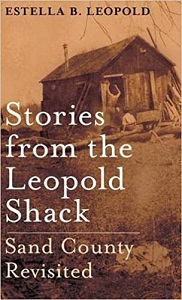
Stories from the Leopold Shack: Sand County Revisited


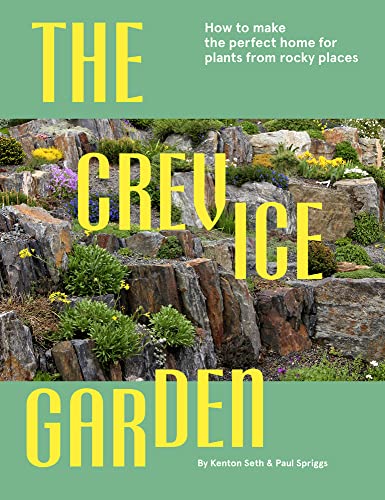 In May 2022, I visited the Denver Botanic Gardens. After I tore myself away from the array of tall bearded iris at the peak of bloom, I found nearby different renditions of the traditional rock garden. The rocks were not the smooth, roundish boulders but instead craggy slates, positioned vertically and close together, with only a limited cracks for the plants.
In May 2022, I visited the Denver Botanic Gardens. After I tore myself away from the array of tall bearded iris at the peak of bloom, I found nearby different renditions of the traditional rock garden. The rocks were not the smooth, roundish boulders but instead craggy slates, positioned vertically and close together, with only a limited cracks for the plants.
This was my introduction crevice gardening. This design expands the plant palette for gardeners in the dry, high altitude of the Rockies, but also in our own cool Mediterranean climate, by providing protection from wet winters that kill many plants.
It is appropriate that the new, and almost only, book on this topic – “The Crevice Garden” – has two authors that represent these climate extremes. Kenton Seth is from western Colorado. Paul Spriggs understands the needs of Seattle area gardeners from his crevice garden in Victoria, B.C. Both have careers as gardeners, and discovered their passion for alpine plants in part through backpacking and mountain climbing.
A crevice garden has more rocks than a traditional rock garden, covering at least half of the surface and typically raised to resemble an outcropping of rock. This keeps the plant tops and roots widely separated and in conditions they both prefer. The roots need the deep run with dependable moisture and even temperatures. The leaves and flowers stay dry and free of excessive moisture.
How do you do it? The design process is somewhat complex, but a detailed guide will take you through each step, from calculating how much of each material (rock, soil, dressing) to design and garden placement. And yes, planting! Some 250 plants are recommended, many new to me, but all sound intriguing. Most important is a location where you can watch your (often tiny) treasures from close by.
Several case studies display beautiful examples, including the garden at Far Reaches Farm in Port Townsend, Washington, appropriately titled “alpines in wet winters.” The authors appreciate that “gardening continues to be our most common connection to nature” and hope readers will embrace crevices to explore plants previously only available to keen specialists.
Reviewed by Brian Thompson for Garden Notes: Northwest Horticultural Society, Fall 2022
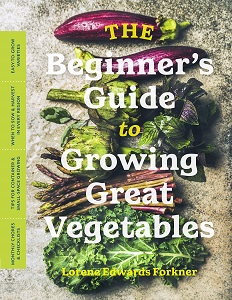
Not just for beginners, Lorene Edwards Forkner’s latest vegetable gardening book is chock full of good advice for all gardeners. If you are a beginner, I suggest reading the opening chapter, “Gardening 101.” For everyone, the chapter entitled “Garden Planning” will help you decide what type and especially how much food growing is realistic for you, including options if you do not have garden space. Like ornamental plants? These are encouraged for edible fruits or flowers, or to attract beneficial insects to protect or pollinate your food crops.The book’s core is a month-by-month calendar showing both the planning and the doing for the time of year, including seasonal essays. For example, September is the time to plan for your fall and winter garden, planting cover crops and saving seeds. October is about cleaning and feeding the garden for the future, especially after the first frost, and creating or enhancing your process for making home compost.Forkner encourages experimentation and keeping a journal of the results. She happily shares her personal experiences, good and bad. “Over the years I’ve experimented with sowing ornamental corn, winter wheat, and fancy French melons. Ultimately, I decided that homegrown popping corn is highly overrated, and my cat took up napping in the middle of my ‘wheat field.'” She concludes that the two tiny Charentais melons her efforts produced “were absolutely delicious–well worth the time and garden space they occupied all summer.”While similar in some ways to her 2012 publication The Timber Press Guide to Vegetable Gardening in the Pacific Northwest, this book incorporates nine more years of Forkner’s experience. Check it out!
Reviewed by Brian Thompson for the Leaflet for Scholars, August 2022, Volume 9, Issue 8.Editor’s note: A longer version of Brian’s review was originally published in the Autumn 2021 issue of Northwest Horticultural Society’s Garden Notes.
 Read this book to have fun with tales, myths, legends, and historical facts about British trees. Mark Hooper says the book aims “to explore the space where social history meets natural history” (p. 9). Along the way he ties events familiar and unfamiliar to many individual trees.
Read this book to have fun with tales, myths, legends, and historical facts about British trees. Mark Hooper says the book aims “to explore the space where social history meets natural history” (p. 9). Along the way he ties events familiar and unfamiliar to many individual trees.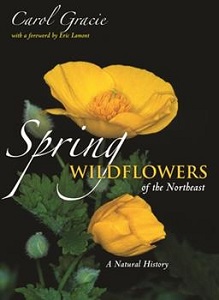 “This book is written for all who share an interest in wildflowers.” Carol Gracie writes this statement in the preface for each of her two books: Spring Wildflowers of the Northeast (published in 2012) and Summer Wildflowers of the Northeast (published in 2020), both with the subtitle “A Natural History.”
“This book is written for all who share an interest in wildflowers.” Carol Gracie writes this statement in the preface for each of her two books: Spring Wildflowers of the Northeast (published in 2012) and Summer Wildflowers of the Northeast (published in 2020), both with the subtitle “A Natural History.” These books are also beautiful, with photographs (by the author) that are both artful and well-chosen to enhance the surrounding text. Further research is encouraged by an impressive appendix of references.
These books are also beautiful, with photographs (by the author) that are both artful and well-chosen to enhance the surrounding text. Further research is encouraged by an impressive appendix of references.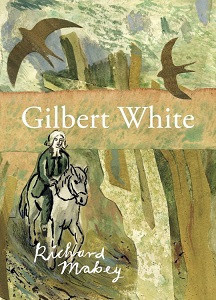
“The language of birds is very ancient, and, like other ancient modes of speech, very elliptical: little is said, but much is meant and understood.”
With this quotation from a letter by Gilbert White, Richard Mabey opened this biography when it was first published in 1986. It offers a nice glimpse into White’s ability to observe and understand nature.
This new edition, with a new foreword but the same opening quotation, brings back to print the man whose single volume, The Natural History of Selborne, helped revise the public view of nature. Published in 1789, Selborne arrived as the rational focus on a well-ordered universe was beginning to clash with Romanticism’s view of nature as wild and alternately terrifying and inspiring. White instead focused on careful and often affectionate observation of natural detail, placed carefully in the setting of an English village. The book marked the beginning of nature writing as we know it.
Gilbert White spent many years recording his observations around the rural village of Selborne in Hampshire. A graduate of Oxford, when that degree alone qualified him to be ordained as clergy, he spent his life in the village where he was born. Mabey records his occasional adventures farther afield in England, usually accompanied by “coach sickness.” He never left England. On a few occasions he acquired a short-term position as curate in a nearby parish, but whenever a permanent place was available, he made little effort to obtain it. He lived on a small inheritance, without paid employment, in the family house in Selborne.
Part of the pleasure of Mabey’s biography is his description, via White’s notes, of Selborne and its neighborhood. The dominating feature is a huge hill Mabey calls “a louring whaleback” that rises 300 feet above street level.
In 1788 the village had 686 inhabitants and was almost totally isolated from the surrounding countryside. White was fascinated by its “hollow lanes,” roads had had sunk below their surroundings due to centuries of wear on the chalk soil beneath them, sometimes by sixteen or eighteen feet. He wrote they “exhibit very grotesque and wild appearances” due to “tangled roots that are twisted among the strata” and from the “torrents rushing down,” especially when frozen. “These rugged gloomy scenes affright the ladies when they peep down into them from the paths above” and “make timid horsemen shudder” (p. 26).
White was also an enthusiastic gardener. He recorded his activities in what he called “The Gardener’s Kalendar.” ( The Garden Diary of Dr. Darwin, reviewed in the Leaflet in May describes a similar, later record by an English amateur gardener.) White planted and tended flowers, often in borders and climbing vines, but he mainly devoted himself to vegetables – more than forty varieties: “including artichokes, endives, mustard and cress, white broccoli, skirret and scorzoner [both root vegetables], marrow fat peas, ‘a remarkable long leek,’ squashes, cucumbers, all manner of lettuces,” plus onions He experimented with maize, wild rice, potatoes – even sea kale (p. 55). The Kalendar records it all.
In 1787, after much delay and prodding from friends and relatives to finish, White sent the first sections of The Natural History of Selborne to the printers He chose an epistolary form. Epistolary novels like Samuel Richardson’s Pamela were extremely popular in the 18th century. White used many letters he had written to friends, but he also created letters he had never sent, and he edited often, cutting some passages, moving parts of others so similar topics appeared together, and added new material. After a flurry of editing and proofreading, with help from friends, at last his book was published in 1789. It received positive reviews, but only in the 1830s, after White’s death, did its sales soar, and its fame make it the quintessential volume of English rural life.
White never married, but he regularly entertained friends and family, including multiple nieces and nephews. After Selborne’s publication he continued keeping his journal and welcoming visitors to his home until his death a few years later in 1793.
In this winsome account of a quiet life, Mabey shows how The Natural History of Selborne emerged from the ever-curious mind of White and the natural and intellectual world around him.
Reviewed by Priscilla Grundy for the Leaflet for Scholars, July 2022, Volume 9, Issue 7.

Known to Instagram followers as an ‘influencer,’ Plant Kween grows over 200 houseplants (the ‘gurls’ of the book’s title) in a small Brooklyn apartment. Christopher Griffin dedicates this book to the grandmother whose love of plants and gardening made a strong impression on him at a tender age.
Written in a conversational style, and providing the expected horticultural details one might need to keep a plant alive indoors, there are many unexpected aspects to this book: it is the first houseplant book I’ve encountered that comes with a playlist! Griffin is the opposite of snobbish, not a seeker of the rarest of plants for their own sake. Plants that can thrive and whose beauty brings delight are the important thing.
While anthropomorphizing plants, Griffin also phytomorphizes humans: “We are basically houseplants with complex emotions.” Caring for plants is inextricably linked to caring for one’s own well-being. He reflects on the ways that we might judge ourselves as ‘not having a green thumb,’ and recounts an apocryphal tale about the term’s origins which puts things in perspective. Griffin takes a forgiving and encouraging stance on gardening as an ongoing learning experience that is open to anyone.
As someone immune to the allure of Instagram who mainly grows plants outdoors, I was nevertheless charmed by this book’s ebullient enthusiasm for growing green ‘gurls.’ To quote the author, “This book is filled with that Black queer nonbinary femme plant parent joy!”
 Before he was known as a landscape architect, Frederick Law Olmsted was best known for a series of articles he wrote for “The New York Daily Times” (now “The New York Times”) and later books he published about his travels in the southern United States between late 1852 and the summer of 1854. He was keen observer and reported quite accurately and in great detail on the economic and social structures, especially the practice of slavery.
Before he was known as a landscape architect, Frederick Law Olmsted was best known for a series of articles he wrote for “The New York Daily Times” (now “The New York Times”) and later books he published about his travels in the southern United States between late 1852 and the summer of 1854. He was keen observer and reported quite accurately and in great detail on the economic and social structures, especially the practice of slavery.
“Olmsted South: Old South Critic, New South Planner” is a collection of scholarly essays written in the 1970s that in part analyze the change in Olmsted’s attitude during his travels. By the end, he is convinced that slavery is disastrous not only for the enslaved but for the entire society. This would later influence his work as a landscape architect: “Underlying his plans for each park, parkway, campus, and suburb was an understanding of the past expressed in the natural history of the site as well as in the growth and development of American society” (quoted from the Foreword of “Olmsted South” by Albert Fein).
Excerpted from Brian Thompson’s article in the Summer 2022 issue of the Arboretum Bulletin
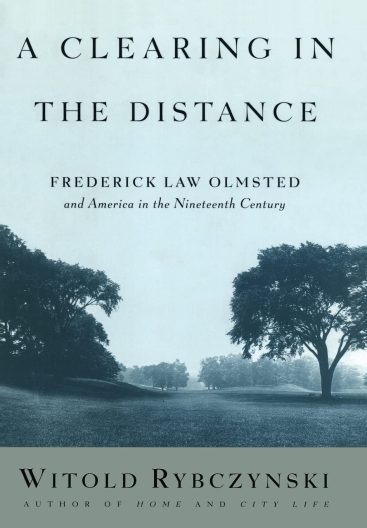 “A Clearing in the Distance” by Witold Rybczynski was published in 1999 but has stood the test of time. The author takes a personal approach, interjecting his opinions on the actions of his subject: “And now, I feel myself becoming impatient with Olmsted. Why can’t he just get on with it?”
“A Clearing in the Distance” by Witold Rybczynski was published in 1999 but has stood the test of time. The author takes a personal approach, interjecting his opinions on the actions of his subject: “And now, I feel myself becoming impatient with Olmsted. Why can’t he just get on with it?”
Because of this level of engagement, I recommend this book as a good starting point for learning about both Olmsted’s personal and professional life. The integration of contemporary and modern perspectives and vignettes is a very effective approach for describing an era to readers 150 and more years later.
The author is also adept at illustrating the qualities in Olmsted that best define his profession: the ability to form a long range vision, and live with it through the scrutiny and compromise to conclusion, or to know when to cut your losses and move on to the next project.
Rybczynski’s research includes visits to surviving projects, such Brooklyn’s Prospect Park or Montreal’s Mount Royal. He also is familiar with the Olmsted plan for Tacoma, describing the solution of the hilly site as “an elegant solution” and lamenting that “the railroad directors would have none of it.”
Excerpted from the Summer 2022 issue of the Arboretum Bulletin
This older biography of Frederick Law Olmsted, Sr. has stood the test of time and I recommend it. Laura Wood Roper writes in the style of an investigator and reporter. Her book “FLO”, published in 1973, is based on over 20 years of research, including the invaluable input of personal interviews from Frederick Olmsted, Jr. near the end of his life.
While always the observer, Roper’s wry comments eloquently express her opinions about Olmsted’s personality and those of the people with whom he was associated. She gives a more complete picture than most of Mary Olmsted, who was first the wife of Frederick’s beloved brother John. Following his death, she married Frederick and brought not only three stepchildren, but an immeasurable influence on his career.
The author is adept at illustrating the qualities in Olmsted that best define his profession: the ability to form a long range vision, and live with it through the scrutiny and compromise to conclusion, or to know when to cut your losses and move on to the next project. As Roper summarizes, “Nothing in Olmsted’s correspondence suggests that such failures of influence made him lose heart or doubt the eventual effectiveness of his work.” This quality, even more than the landscapes he left us, may be ultimately what makes the life of Frederick Law Olmsted, Sr. so appealing.
Excerpted from the Summer 2022 issue of the Arboretum Bulletin